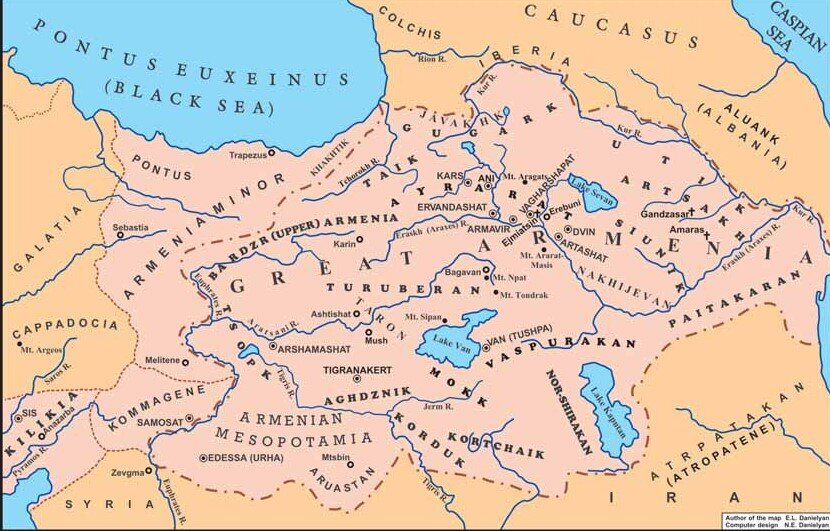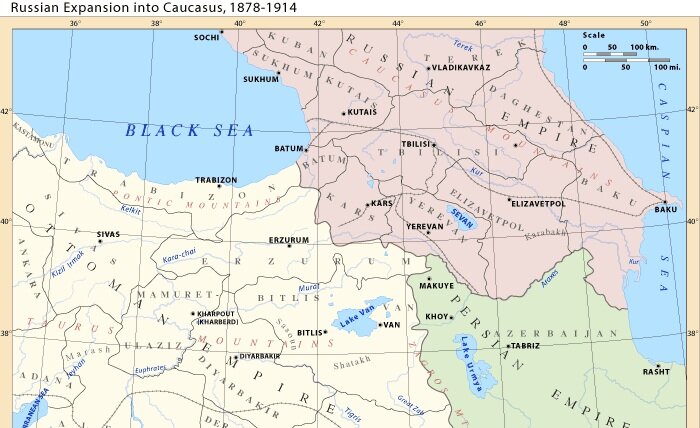Know Your Facts: A Historical Overview of Artsakh
Nagorno-Karabakh (capital Vararak-Stepanakert) is the modern name of the mountainous part of the Armenian region of Artsakh. In ancient and medieval times Artsakh was the 10th province of Great Armenia. According to the Greek geographers Strabo (64 BC – 24 AD) and Claudius Ptolemy (83-161 AD), Great Armenia was bordered in the north by a part of Colchis, by Iberia, and by Albania on the line of the Cyrus (Kura) River. This is where the Armenian king Tigranes II the Great built, as part of his Empire, one of the cities named Tigranakert (Tigranocerta) in the 1st century BC. Artsakh was mainly ruled by the representatives of the Haikian-Sisakian-Aranshahik family. From 484 AD until the first half of the 6th century, the Armenian regions of Artsakh and Utik comprised the Kingdom of Vachagan the Pious.
In the 8th through 9th centuries Artsakh played a decisive role in the struggle for liberation against the Arab conquerors. After the restoration of the Armenian kingdom of the Bagratids in 885, the unifying policy of the King of Kings, Gagik I (989-1020) allowed for the Armenian princedoms of Khachen (in Artsakh), Gardman (in Utik) and others to become integral parts of the Ani-Shirak kingdom. Following the fall of the Bagratid kingdom, the struggle of northeast Armenia against the invasions of Seljuk-Turks bands was led by the Armenian Zakaryan princely family, who liberated Artsakh. The region suffered greatly in the 15th and 16th centuries from the raids of the Turkmen nomadic tribes Aq-Qoyunlu and Qara-Qoyunlu. From the 15th to the 17th centuries, in both parts of Armenia, the Turkish-Persian conquerors aimed to destroy the traditional Armenian administrative-political structure by repopulating Armenia with Kurdish and Turkic tribes, who implanted Islamic laws and rights. Despite these efforts, the Armenian princes continued to preserve their rights in certain regions and even enjoyed local self-government in semi-independent princedoms, such as Khachen, Varanda, Sodk, Tsar, etc. in Eastern Armenia - mainly in Siunik and Artsakh. They were ruled by princes (meliks) and were known as melikates.
In order to insulate the Armenian meliks from Russophile aspirations, prevent new rebellions, and establish a buffer zone between Iran and the Ottoman Empire, the Iranian commander Nadir-Khan strengthened the sovereignty of the Armenians and established in the territory of Karabagh and part of Siunik five Armenian melikates, the so-called “Melikates of Khamsa” (khamsa means “five” in Arabic): Gyulistan (the meliks Beglaryans), Djraberd (the Israelyans), Khachen (the Hassan-Jalalyans), Varanda (the Shahnazaryans) and Dizak (the Eghanyans). During the semi-independent periods of the Melikates of Khamsa until 1747, a relatively more peaceful life existed in Artsakh, Siunik, and other regions of Eastern Armenia. The Russian victory in the Russo-Turkish wars of 1768- to1774 had strengthened the position of Russia in the north of the Black Sea and created the basis for the tsarists’ foreign policy in Transcaucasia. The Russian forces with the support of Christian nations had great success․ In 1805, Shirak and Karabagh had come under the Russian protectorate. Russia’s new victories over Iran in 1813 ended the Russo-Persian War (1804-1813). Iran accepted the joining with Russia of a number of regions of Eastern Armenia – Lori, Pambak, Ghazakh (with Idjevan), Shamshadin, Shirak, Karabagh, Zangezur, and Eastern Transcaucasia. Karabagh was again invaded by Prince Abbas-Mirza’s 60 000-man army when the war between Russia and Iran (1826-1828) reconvened in mid July 1826.
In the late 1830s, a group of Russian officials imposed a new administrative structure on Transcaucasia. In accordance with the law of April 10, 1840 the Transcaucasian region was divided into two political units – the Georgian-Imeretian gubernia (province) and the Caspian region, ignoring the cultural-ethnic and social-economic interests of the Armenian people in these areas. A part of this division, the Karabagh uyezd (Russian administrative subdivision) was included in the Caspian region. In 1867, the new tsarist officials’ administrative and economic reforms in Transcaucasia established the Elizavet gubernia, which was among other new gubernias comprised of the lower and upper (nagorni) parts of Karabagh (Artsakh)..
After the February bourgeois-democratic revolution and the revolutionary rebellion of the Bolsheviks on October 25, 1917, a new process of state formation began among the peoples under Russian rule. On May 27, 1918 the newly founded Azerbaijan*, (Sovietized on April 28, 1920), supported by Turkish nationalist and political leader Mustafa Kemal, continued the Musavat pan-Islamic and pan-Turkic line of territorial expansion by making claims on Armenian lands – Karabagh, Zangezur and Nakhichevan. The Russo-Armenian negotiations on these territorial issues in Moscow failed. However, on August 10 in Tiflis the authorized persons of the governments signed an agreement, according to which the Russian forces would occupy the “disputable territories” of Karabagh, Zangezur and Nakhichevan.
On June 12, 1921, the government of Armenia proclaimed that “Nagorno-Karabagh is an imprescriptible part of Armenian SSR’’. Azerbaijan opposed this declaration, and the Commission on the Determination of Transcaucasian Republics’ Frontiers was called in Tiflis where, under the pressure of the representative of Azerbaijan, it was decided to move the resolution of the issue to Moscow. On July 4, 1921 the decision regarding the Karabagh issue was found to be fair by the Caucasian Bureau of the CC CP (Central Committee of the Communist Party), which made a statement to include Nagorno-Karabagh in the Armenian SSR (Armenian Soviet Socialist Republic). However, on July 5, the Caucasian Bureau instead adopted a resolution to include Nagorno-Karabagh within the borders of Azerbaijan, while granting Nagorno-Karabagh a wide regional autonomy with an administrative center in Shushi․ This decision raised the protest of the Karabagh population, where 95 percent of the population was Armenian, as well as of party and Soviet bodies of Armenia, including the Plenum of the CC CP of Armenia (July 16, 1921) and the First Congress of the CP of Armenia (January 1922).
On July 7, 1923, the Nagorno-Karabakh Autonomous Region (NKAR) was established in a part of Artsakh within Soviet Azerbaijan. Stalin played the main role in both cases of handing over the Kars region to Turkey, and Nakhichevan and Nagorno-Karabagh to Azerbaijan. In addition to the Friendship Treaty (March 16, 1921) between the Grand National Assembly of Turkey (TBMM) under the leadership of Mustafa Kemal Atatürk and Bolshevist Russia, an important consideration in these territorial decisions was also the matter of securing oil assistance from Azerbaijan to Russia, which was in a dire economic situation.
Despite the party and administrative prohibitions, thousands of Karabagh Armenians continued to apply to the CC CP of the USSR (Union of Soviet Socialist Republics) with complaints about the infringement of the rights of Armenians in both NKAR and the Nakhichevan autonomous republic by the Azerbaijani authorities. By submitting these matters to the CC CP, the Karabagh Armenians hoped to restore the historical justice and to join Nagorno-Karabagh with Soviet Armenia.
In 1985, General Secretary of the CP of the Soviet Union, Mikhail Gorbachev, issued a new doctrine known as “revolutionary perestroika”, “democracy”, and “national autonomy.” This doctrine brought the mighty Artsakh movement to a head, which turned into a new stage of the Armenian national-liberty movement.
On February 12, 1988 the first mass demonstration demanding that NKAR join with the Armenian SSR was organized in Stepanakert. Anti-Armenian propaganda was being disseminated in Azerbaijan, which led to the massacres of Armenians in Sumgait, Kirovabad (Gandzak) (1988), and Baku (1990). On December 1, a decree on the reunion of Nagorno-Karabagh with Armenia was adopted at the Joint Session of the Armenian SSR Supreme Soviet and the National Soviet of Nagorno-Karabagh, which was elected in Stepanakert on August 16, 1989. The Presidium of the Supreme Soviet of the USSR characterized the joint Decree of the Session of the Armenian SSR Supreme Soviet and National Soviet of Nagorno-Karabagh as an “anti-Constitutional act.” A new wave of persecutions and pogroms targeting Armenians, as well as deportations from Kirovabad (Armenian Gandzak-Elizabethpo-Gyanja), Nakhichevan, and other localities of Azerbaijan were launched.
Protestors in Stepanakert, 1988
A house belonging to Armenians after the pogrom by Azerbajzanians in Sumgait, 1988
On September 2, 1991, the “Declaration on the Establishment of the Nagorno-Karabagh Republic” was adopted in Stepanakert. During the referendum held on December 10, 99 percent of the Nagorno-Karabagh population voted for the independence of the Nagorno-Karabagh Republic as a state “self-determining the forms of cooperation with other countries and communities.” The Armenians of Nagorno-Karabagh had expressed their weighty will to establish their own independent state. Armenian self-defense forces opposed the aggressions of Azerbaijan from 1991 to 1994. The long liberation struggle of the people of Artsakh achieved victory. In May 1994 Azerbaijan, failing to break the resistance of Armenians and solve the Karabagh problem by force, had to sign an armistice treaty in Bishkek, with intermediation by Russia and the Minsk group.
A priest conducts a service before the Armenian freedom-fighters go to battle, 1991
Despite the Ceasefire Accord, sporadic fighting in the area occurs time and again. On April 1, 2016, Azerbaijan’s armed forces launched heavy offensives along the Line of Contact, provoking large-scale confrontations with the Defense Army of Nagorno-Karabakh. The adversary forces of Azerbaijan were pushed back again after the Four-Day War.
In February 2017, the Nagorno-Karabakh Republic officially became the "Republic of Artsakh".
1. The name of “Azerbaijan” historically corresponds only to the Iranian province of Atropatene-Adarbaigan-Azerbaijan. According to Strabo, ancient Atropatene was located to the south-east of the Kingdom of Great Armenia. In the second half of 1918 this name was appropriated from the Iranian north-western province of Azerbaijan and with Pan-Turkic purposes was given to the artificially formed “Eastern-Caucasian Muslim Republic” or “the Tartar Republic of Azerbaijan”. It was then applied to “Azerbaijan SSR” (aiming to annex Iranian Azerbaijan). In the Russian Imperial (the second half of 19th- the beginning of the 20th cc.) and then the Soviet official documents (until the 1930s) the alien Turkic elements in the Cis-Caspian region were called “Tatars”, “Caucasian Tatars”, “Turks”. The new term “Azerbaijani(s)” officially started to be used in the USSR since the end of the 1930s.





